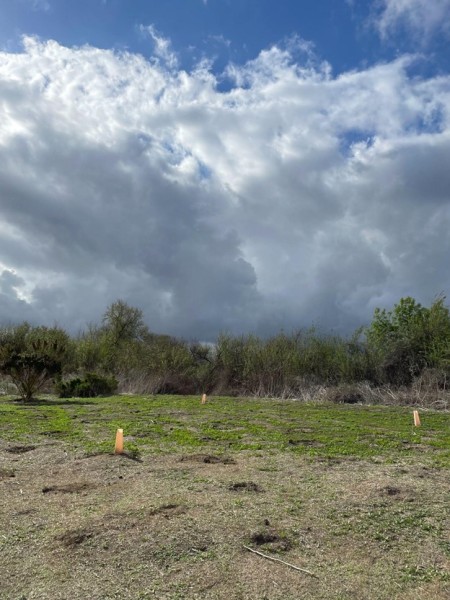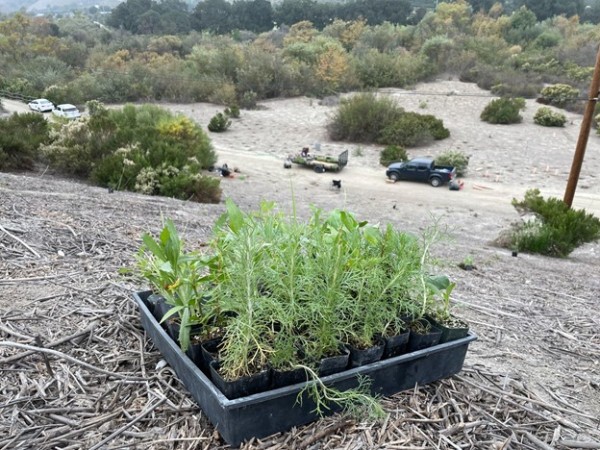You can see our newest restoration project if you ever find yourself hiking along the Aliso Creek Trail. It is located in the Aliso and Wood Canyons Wilderness Park in Aliso Viejo. Within this park, we have three large-scale restoration projects happening at different stages of completion. We are currently in year two of this project, where our team has prepared the site, planted, seeded, and maintained weeds.
If you ever wonder what goes into a restoration project, here’s how our team has done these last two seasons in the “WCB Project.”
Site Preparation:
First, dry black mustard stocks were cut down using string trimmers/weed whackers. After, the dry plant material was collected and disposed of. The ground must be clear of any plant material to prepare for seeding. If any weeds pop up after clearing the area, they have to be removed.
Seeding:
We used two seeding techniques to spread 450 pounds of seeds. One of our techniques is hand seeding, which we used on the flat areas of the project. The process of hand seeding goes as follows: first, the soil is racked in one direction to create lines on the surface. Second, seeds are spread by throwing them throughout the racked areas. Next, the soil is racked in the opposite direction of the lines that were made previously. The last step for seeding is to stamp the soil to cover the seeds using a seed roller, a large, heavy cylinder pushed around to flatten the soil. Our second technique was done on the South slopes of the project, where we used the hydroseeding method. This technique is a mixture of seeds, mulch, and water launched from a large hose to cover the desired area. The mulch helps the seeds stick on the slopes to germinate.

Planting:
After hand seeding, 11,000 native plants were installed in the flat sections of the project. Some of the species of plants that were installed were: bush sunflower, California blackberry, California buckwheat, toyon, and lemonade berry, among other native plant species. When planting, it’s vital to pre-water the hole before installing the plant to promote deep root growth. After the plant is installed in the ground, it gets watered one last time. In large-scale projects like this, irrigation after planting is very time-consuming and expensive. Since no further watering is done, all we can do is wait for some rain to water the plants naturally. Vulnerable species are covered with tree sentries to protect them from herbivory and the extreme heat in their first year on the ground.

During the 2nd year of the project, another 10,800 plants were installed. A portion of those plants were planted on the north slopes. Unfortunately, sometimes plants don’t survive due to the lack of rain and long periods of extreme heat. The remainder of the plants were used to fill in any areas with low plant survival rates from last year.
Weed Maintenance:
After putting the plant material in the ground in the form of seedling or seed, the next step is to manage invasive plant species. It is crucial to remove invasive species to give the native plants a chance to grow—invasive species take away essential resources for native plants like sunlight, soil nutrients, space, and water. The invasive species of greater concern at the WCB project are the species of mustard. They grow faster than native plants, which will take resources away from them.
What’s next on the project? Lots of invasive species management. For the remainder of this project, the main goal is to keep all invasive species at a low quantity or completely gone from the site.
